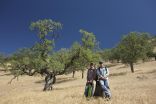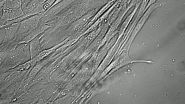(Press-News.org) As California finally experiences the arrival of a rain-bearing Pineapple Express this week, two climate scientists from the University of Minnesota and Woods Hole Oceanographic Institution have shown that the drought of 2012-2014 has been the worst in 1,200 years.
Daniel Griffin, an assistant professor in the Department of Geography, Environment and Society at the University of Minnesota, and Kevin Anchukaitis, an assistant scientist at Woods Hole Oceanographic Institution, asked the question, "How unusual is the ongoing California drought?" Watching the severity of the California drought intensify since last autumn, they wondered how it would eventually compare to other extreme droughts throughout the state's history.
To answer those questions, Griffin and Anchukaitis collected new tree-ring samples from blue oak trees in southern and central California. "California's old blue oaks are as close to nature's rain gauges as we get," says Griffin. "They thrive in some of California's driest environments." These trees are particularly sensitive to moisture changes and their tree rings display moisture fluctuations vividly.
As soon as the National Oceanic and Atmospheric Administration (NOAA) released climate data for the summer of 2014, the two scientists sprang into action. Using their blue oak data, they reconstructed rainfall back to the 13th century. They also calculated the severity of the drought by combining NOAA's estimates of the Palmer Drought Severity Index (PDSI), an index of soil moisture variability, with the existing North American Drought Atlas, a spatial tree-ring based reconstruction of drought developed by scientists at Columbia University's Lamont-Doherty Earth Observatory. These resources together provided complementary data on rainfall and soil moisture over the past millennium. Griffin and Anchukaitis found that while the current period of low precipitation is not unusual in California's history, these rainfall deficits combined with sustained record high temperatures created the current multiyear severe water shortages. "While it is precipitation that sets the rhythm of California drought, temperature weighs in on the pitch," says Anchukaitis.
"We were genuinely surprised at the result," says Griffin, a NOAA Climate & Global Change Fellow and former WHOI postdoctoral scholar. "This is California--drought happens. Time and again, the most common result in tree-ring studies is that drought episodes in the past were more extreme than those of more recent eras. This time, however, the result was different." While there is good evidence of past sustained, multi-decadal droughts or so-called "megadroughts"' in California, the authors say those past episodes were probably punctuated by occasional wet years, even if the cumulative effect over decades was one of overall drying. The current short-term drought appears to be worse than any previous span of consecutive years of drought without reprieve.
Tree rings are a valuable data source when tracking historical climate, weather and natural disaster trends. Floods, fires, drought and other elements that can affect growing conditions are reflected in the development of tree rings, and since each ring represents one year the samples collected from centuries-old trees are a virtual timeline that extend beyond the historical record in North America.
So what are the implications? The research indicates that natural climate system variability is compounded by human-caused climate change and that "hot" droughts such as the current one are likely to occur again in the future. California is the world's 8th largest economy and the source of a substantial amount of U.S. produce. Surface water supply shortages there have impacts well beyond the state's borders.
With an exceptionally wet winter, parts of California might emerge from the drought this year. "But there is no doubt," cautions Anchukaitis, "that we are entering a new era where human-wrought changes to the climate system will become important for determining the severity of droughts and their consequences for coupled human and natural systems."
The results of their study are published this week in Geophysical Research Letters in the article, "How unusual is the 2012-2014 California Drought?"
INFORMATION:
The Woods Hole Oceanographic Institution is a private, non-profit organization on Cape Cod, Mass., dedicated to marine research, engineering, and higher education. Established in 1930 on a recommendation from the National Academy of Sciences, its primary mission is to understand the ocean and its interaction with the Earth as a whole, and to communicate a basic understanding of the ocean's role in the changing global environment. For more information, please visit http://www.whoi.edu.
Genetic mutations may cause more cases of amyotrophic lateral sclerosis (ALS) than scientists previously had realized, according to researchers at Washington University School of Medicine in St. Louis and Cedars-Sinai Medical Center in Los Angeles. The scientists also showed that the number of mutated genes influences the age when the fatal paralyzing disorder first appears.
ALS, also known as Lou Gehrig's disease, destroys the nerve cells that control muscles, leading to loss of mobility, difficulty breathing and swallowing, and eventually paralysis and death. Understanding ...
The Institute for Quality and Efficiency in Health Care (IQWiG) investigated in a dossier assessment whether propranolol offers an added benefit in comparison with the appropriate comparator therapy in infants with proliferating infantile haemangioma (sometimes called "strawberry mark").
According to the findings, there is an indication of major added benefit of propranolol in some children, i.e. those with haemangioma with a risk of permanent scars or disfigurement. In contrast, an added benefit is not proven for children with life- or function-threatening haemangioma, ...
The vicious cycle of diabetes describes a scenario where people are becoming fatter, often with elevated levels of glucose, and at increased risk for women to develop gestational diabetes (GDM). Intrauterine exposure to GDM, itself, is a major risk factor for later obesity and diabetes, thus perpetuating this maternal-offspring cycle of disease.
Researchers from Lund University have published an overview of evidence across the past few decades in the journal Diabetes, Metabolic Syndrome and Obesity: Targets and Therapy. They emphasize the need to update diabetes prevention ...
It means cancer "in place" but a carcinoma "in situ" often does not want to keep its place. Standing between a cancer cell in situ and the surrounding tissue of fibroblasts and extracellular matrix is the basement membrane, a thin sheet of fibers that normally cradles the cells above it. The basement membrane is also the frontline physical barrier that keeps primary tumors from spreading into the matrix below. Perforating the basement membrane is a cancer cell's first move toward invasion, but how? Fibroblasts are most commonly found in connective tissue that synthesizes ...
In the human brain, the BBB is not the Better Business Bureau but the blood brain barrier and the BBB is serious business in human physiology. The human BBB separates circulating blood from the central nervous system, thus protecting the brain from many infections and toxins. But the BBB also blocks the passage of many potentially useful drugs to the brain and it has long stymied scientists who want to learn more about this vital tissue because of the lack of realistic non-human lab models. Even less is known about the BBB in children. There are significant structural and ...
VIDEO:
This 19-second time lapse video shows the first six hours of neuronal conversion of skin fibroblasts from a patient with Alzheimer's disease.
Click here for more information.
The search for a living laboratory model of human neurons in the grip of Alzheimer's disease (AD)--the so-called "Alzheimer's in a dish"--has a new candidate. In work presented at the ASCB/IFCB meeting in Philadelphia, Håkan Toresson and colleagues at Lund University in Sweden report success ...
Location, location, location goes the old real estate proverb but cancer also responds to its neighborhood, particularly in the physical surroundings of bone marrow cells where human myeloid leukemias arise and where, according to two Harvard bioengineers, stiffness in the surrounding extracellular matrix (ECM) can predict how cancer subtypes react to chemotherapy. Correcting for the matrix effect could give oncologists a new tool for matching drugs to patients, the researchers say.
In work to be presented at the ASCB/IFCB meeting in Philadelphia, Jae-Won Shin and David ...
Alzheimer's disease (AD) progresses inside the brain in a rising storm of cellular chaos as deposits of the toxic protein, amyloid-beta (Aβ), overwhelm neurons. An apparent side effect of accumulating Aβ in neurons is the fragmentation of the Golgi apparatus, the part of the cell involved in packaging and sorting protein cargo including the precursor of Aβ. But is the destruction the Golgi a kind of collateral damage from the Aβ storm or is the loss of Golgi function itself part of the driving force behind Alzheimer's? This was the question for Yanzhuang ...
VIDEO:
Nucleoli (green), small liquid-like nuclear bodies, are kept small and afloat by a fine actin mesh. When the mesh breaks, the nucleoli quickly being to fall and coalesce into larger...
Click here for more information.
Everybody knows that cells are microscopic, but why? Why aren't cells bigger? The average animal cell is 10 microns across and the traditional explanation has been cells are the perfect size because if they were any bigger it would be difficult to get enough ...
Cells are restless. They move during embryogenesis, tissue repair, regeneration, chemotaxis. Even in disease, tumor metastasis, cells get around. To do this, they have to keep reorganizing their cytoskeleton, removing pieces from one end of a microtubule and adding them to the front, like a railroad with a limited supply of tracks. The EB family of proteins helps regulate this process and can act as a scaffold for other proteins involved in pushing the microtubule chain forward.
Still, how these EB proteins function in space and time has remained a mystery. Now Peng ...



